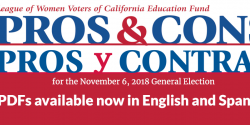Proposition 1: Water Bond. Funding for Water Quality, Supply, Treatment, and Storage Projects
Should the state of California sell $7.1 billion in additional general obligation bonds to fund various water-related programs?
Historically, a majority of California’s surface water has come from Sierra Nevada and Northern California snowmelt that feeds the state’s two largest rivers, the Sacramento and the San Joaquin. Groundwater has provided roughly a third of the state’s water supply, but many of the state’s groundwater basins are currently dangerously depleted. The remainder of the state’s water comes from other sources, such as captured rainwater, water recycling, and desalination.
Much of the state’s surface water is delivered to Central Valley farmland and to population centers in the Bay Area and Southern California. Southern California also gets water from the Owens Valley and the Colorado River. In dry years, it can be difficult to provide all the water needed by California’s cities, agriculture, and environment. In very wet years, the state can experience floods. To address these challenges, the state has built various projects, including pipelines, pumping stations, and canals to move water, and has constructed dams/reservoirs and other types of water storage to manage available surface water. These supplement local water storage and delivery systems.
Since the large water projects were built in the mid-20th century, California’s population has doubled and the value of its economy has multiplied many times. However, California’s growth faces natural limits on the total amount of water available.
In addition to approving water project bonds in the middle of the last century, voters over the decades have approved additional water bonds. A portion of these bonds remain unsold.
Prop. 1 would allow the state to redirect $425 million in unsold bonds and sell $7.1 billion in additional bonds, for a total of $7.5 billion in general obligation bonds. The funds would be used to manage water supplies, protect and restore wetlands, improve water quality, and increase flood protection. Of the total $7.5 billion, $5.7 billion is available for water supply and water quality projects only if recipients provide a local match, in most cases 50% of the total cost.
Who funded this proposal? Visit Voters' Edge.
Assuming an interest rate just over 5% for bonds sold over the next 10 years and repaid over a 30-year period, the cost to taxpayers would average about $360 million annually over the next 40 years. It is assumed that the $425 million in unsold bonds would not increase the state’s anticipated debt payments because the bonds likely would have been sold in any case.
It’s estimated that there would be savings to local governments on water-related projects, likely averaging a couple hundred million dollars annually over the next few decades.

